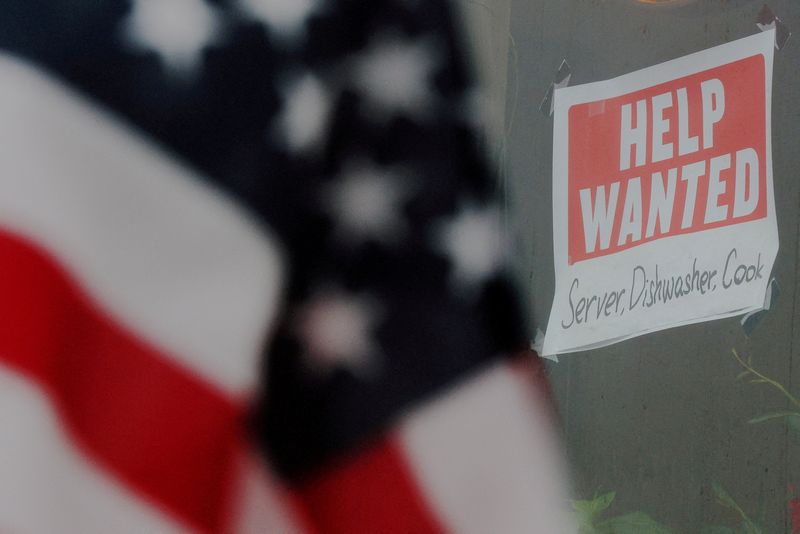By Lucia Mutikani
WASHINGTON (Reuters) - U.S. job growth likely slowed sharply in October amid disruptions from hurricanes and strikes by aerospace factory workers, but a steady unemployment rate should offer assurance that the labor market remained on solid footing ahead of Tuesday's election.
The Labor Department's closely watched employment report scheduled for release on Friday will be the last major economic data before Americans head to the polls to choose Democratic Vice President Kamala Harris or Republican former President Donald Trump as the country's next president.
Polls show the race is a toss-up. Americans have not warmed up to the economy's strong performance, which has outshined its global peers, rankled by high prices for food and rents. Low layoffs have been the hallmark of the labor market's strength.
"The labor market is still relatively solid," said Cory Stahle, an economist at Indeed Hiring Lab. "There's still plenty of opportunities out there, but obviously things have cooled off, and people's experience with the labor market is going to be somewhat dependent on what type of work they're looking for."
Nonfarm payrolls likely increased by 113,000 jobs last month after surging 254,000 in September, a Reuters survey of economists showed. Estimates ranged from no jobs added to 200,000 positions created. October's anticipated payrolls count would be the smallest in six months.
Hurricane Helene devastated the Southeast in late September and Hurricane Milton lashed Florida a week later.
Economists are split on the magnitude of the drag on payrolls from Helene and Milton, with estimates ranging from as low as 25,000 to as many as 70,000 jobs.
"Typically, salaried workers are paid when a business is shut down due to a natural disaster, while hourly workers are not," said Stephen Stanley, chief U.S. economist at Santander (BME:SAN) Capital Markets. "Thus, the largest impacts might be seen in sectors with a high percentage of hourly employees, such as restaurants and retail. Still, unless the fallout is massive, it may be hard to detect."
The Labor Department reported last week that there were 41,400 new workers on strike, including 33,000 machinists at Boeing (NYSE:BA) and 5,000 at Textron (NYSE:TXT), an aircraft company, when employers were surveyed for October's employment report. The remaining 3,400 were workers at three hotel chains in California and Hawaii.
Workers who do not receive a paycheck during the survey period, which includes the 12th day of the month, are counted as unemployed in the survey of establishments from which the payrolls number is calculated. Boeing has embarked on rolling furloughs to conserve cash during the strike, but economists were optimistic that these workers received a paycheck during the survey week.
The impact on payrolls from Boeing suppliers is uncertain, though there have been reports of layoffs.
Estimates for the anticipated payrolls hit from the storms and strikes ranged from 70,000 to about 100,000, concentrated in the construction, manufacturing, retail as well as the leisure and hospitality sectors. Layoffs at Chrysler-parent Stellantis (NYSE:STLA) likely also weighed on manufacturing employment.
NO LABOR MARKET DOWNTURN
"We believe the true underlying pace of job growth was likely around 170,000 in October," said Lydia Boussour, senior economist at EY-Parthenon. "A labor market downturn isn't on the near-term horizon judging by still historically low layoff activity and companies' more strategic management of their workforce via wage compression and strategic resizing efforts."
Indeed, first-time applications for unemployment benefits have dropped to five-month lows, reversing the jump seen in the wake of the hurricanes, signaling a rebound in payrolls in November was likely.
The unemployment rate was seen unaffected by the distortions as the striking workers would be counted as employed in the household survey from which the rate is derived. Workers unable to work because of bad weather would be reported as employed, "with a job, but not at work" as per the BLS' classification.
The unemployment rate was forecast unchanged at 4.1% in October. There is, however, a chance that temporary layoffs related to the Boeing labor strife could lift the jobless rate.
Still, economists said a marginal rise in the unemployment rate would not be alarming and expected the Federal Reserve to sort through the noise and cut interest rates by 25 basis points next Thursday. A rise in the unemployment rate to 4.3% in July from 3.8% in March was one of the catalysts for the U.S. central bank's unusually large half-percentage-point interest rate cut in September, the first reduction in borrowing costs since 2020.
The Fed's policy rate is now set in the 4.75%-5.00% range, having been hiked by 525 basis points in 2022 and 2023.

Though employers have pulled back on hiring, they are retaining their workers, underpinning wage gains and consumer spending. Average hourly earnings were forecast rising 0.3% after gaining 0.4% in September. That would keep the annual increase in wages at 4.0% in October.
"If we look at longer-term trends, the labor market could still be considered healthy," said Rachel Sederberg, a senior economist at Lightcast. "It's important to just remember that we are still in a good space, if we look at ourselves against historic norms."